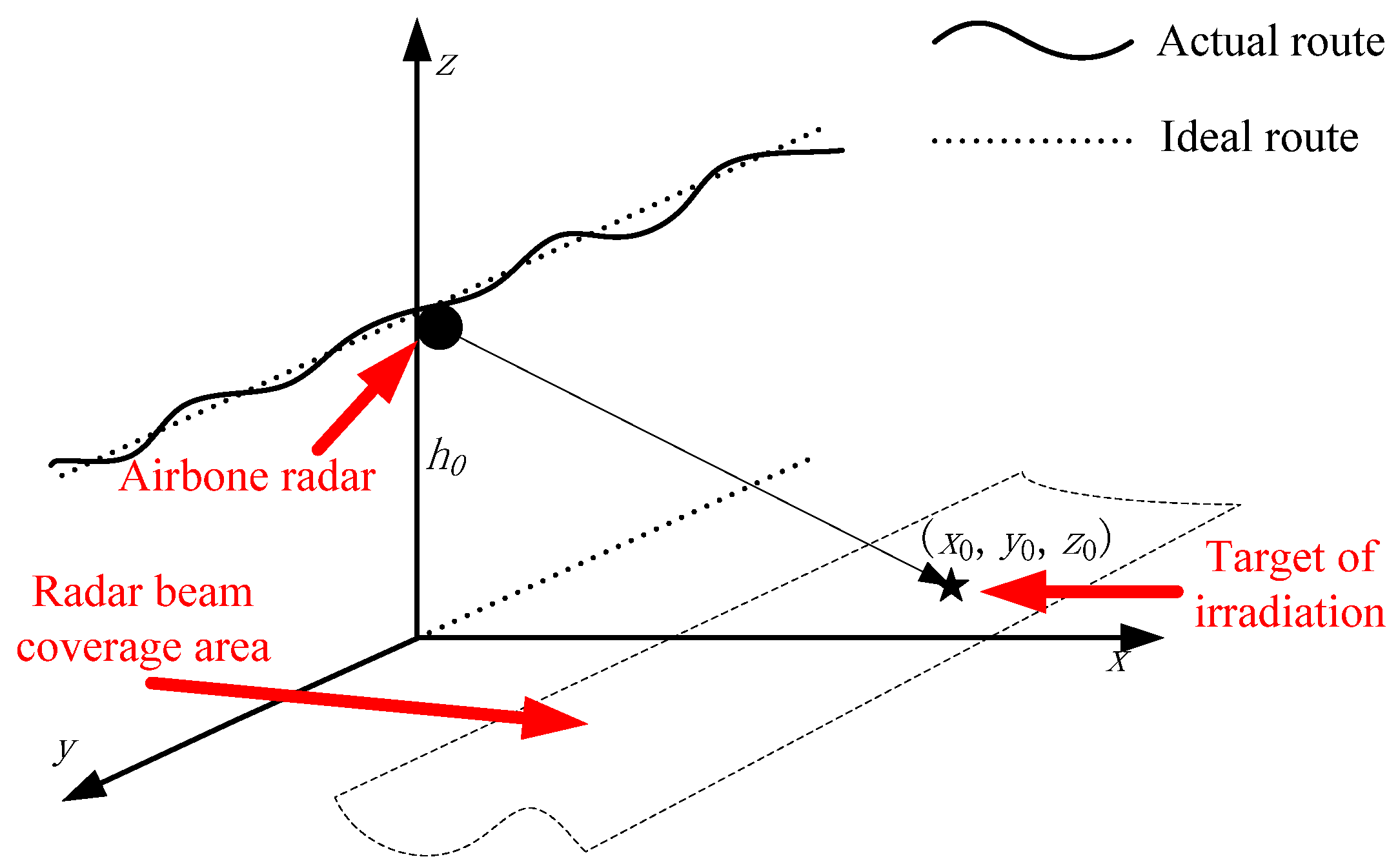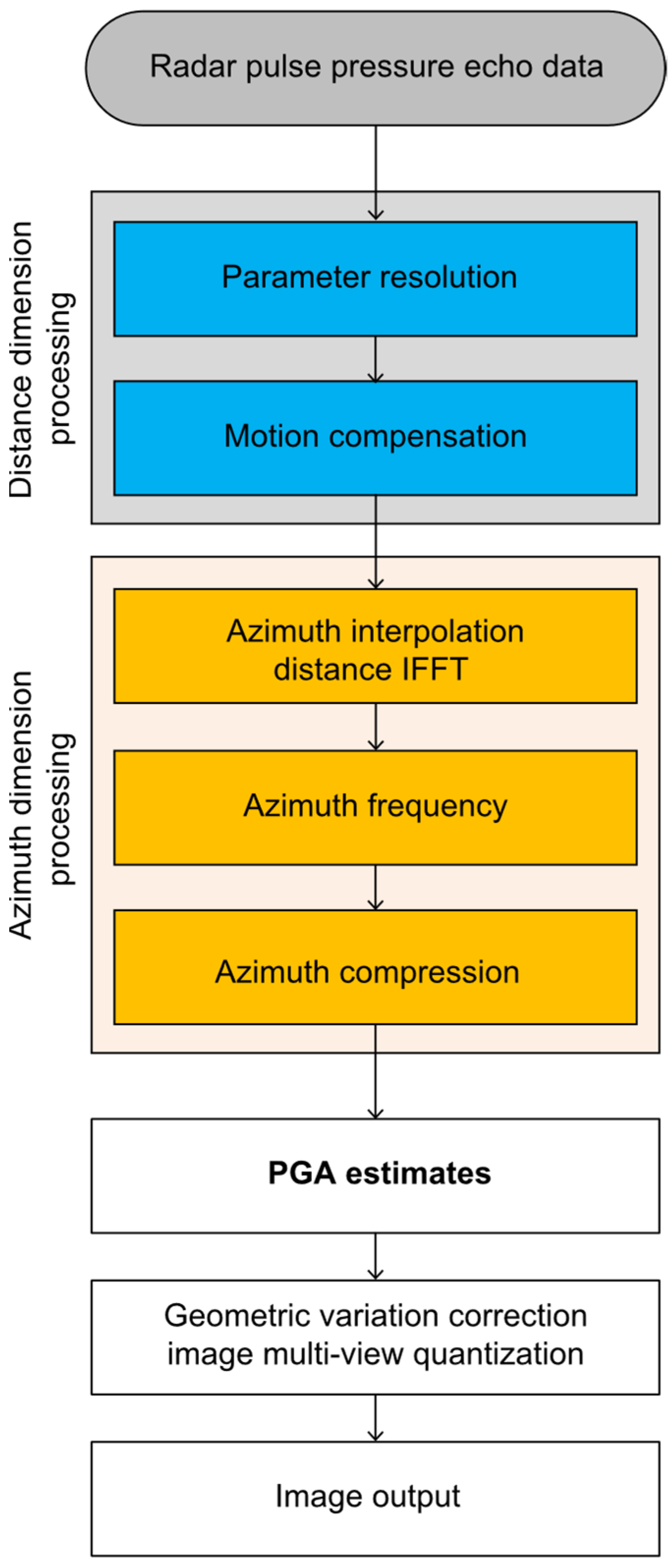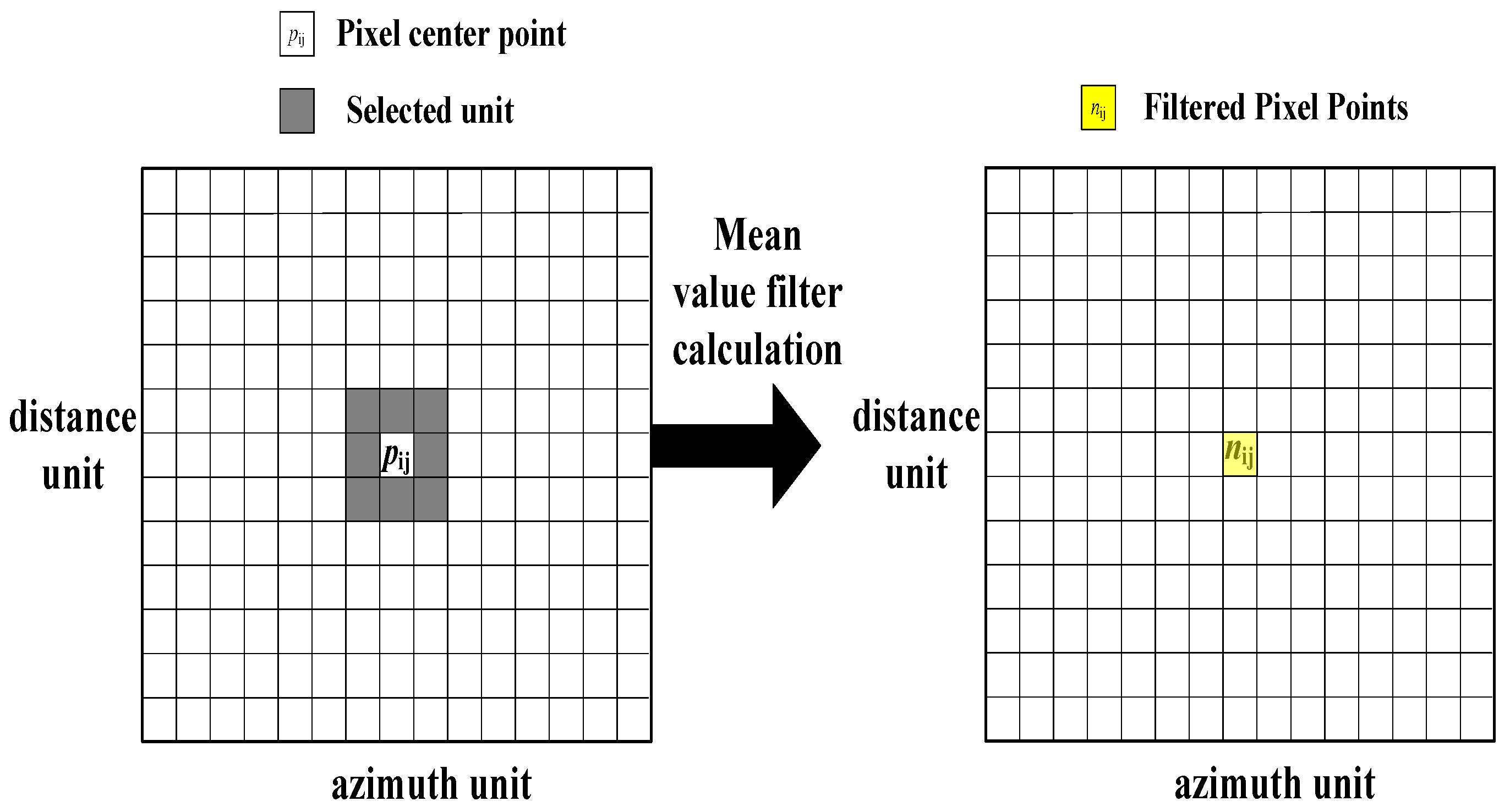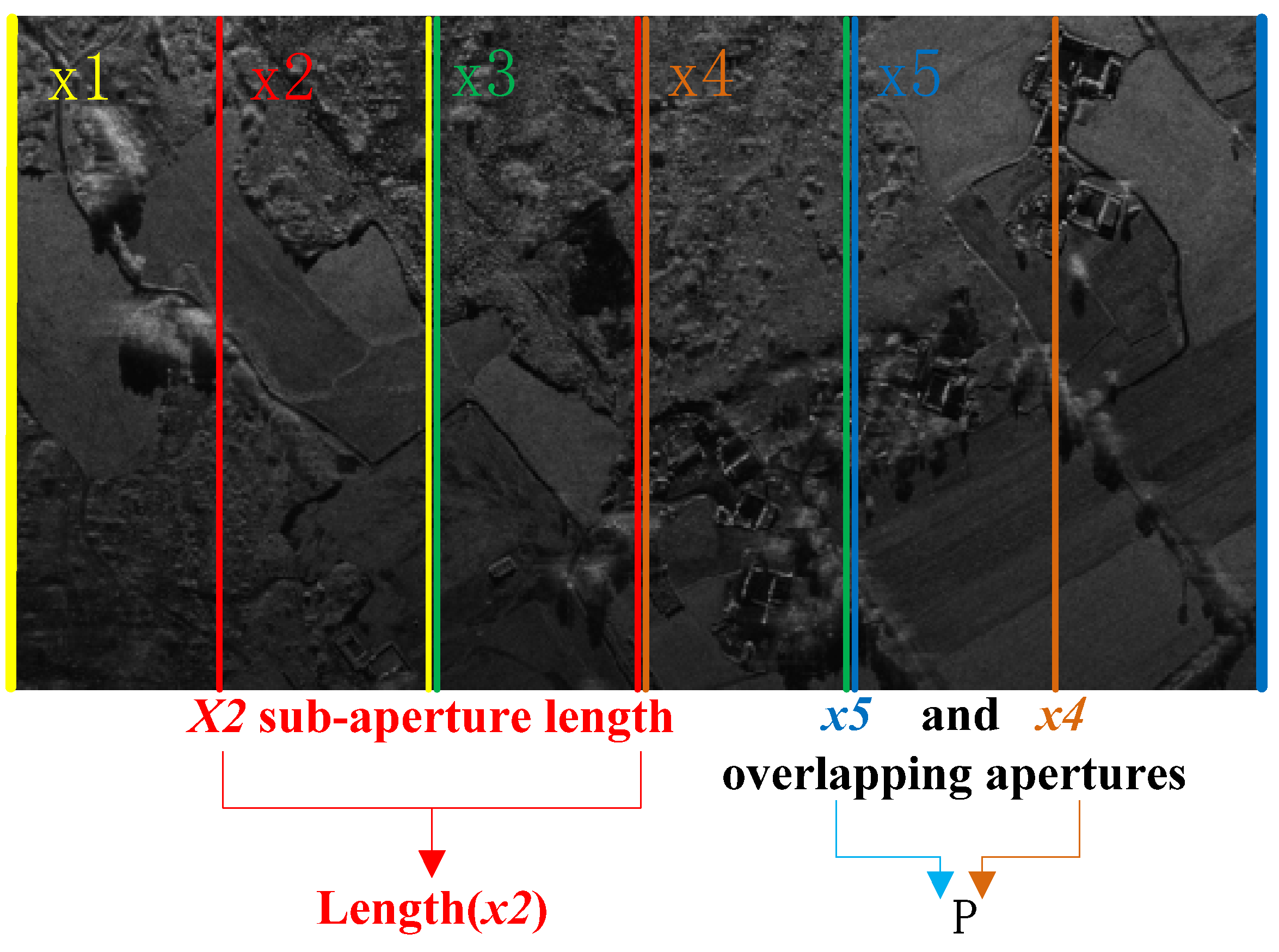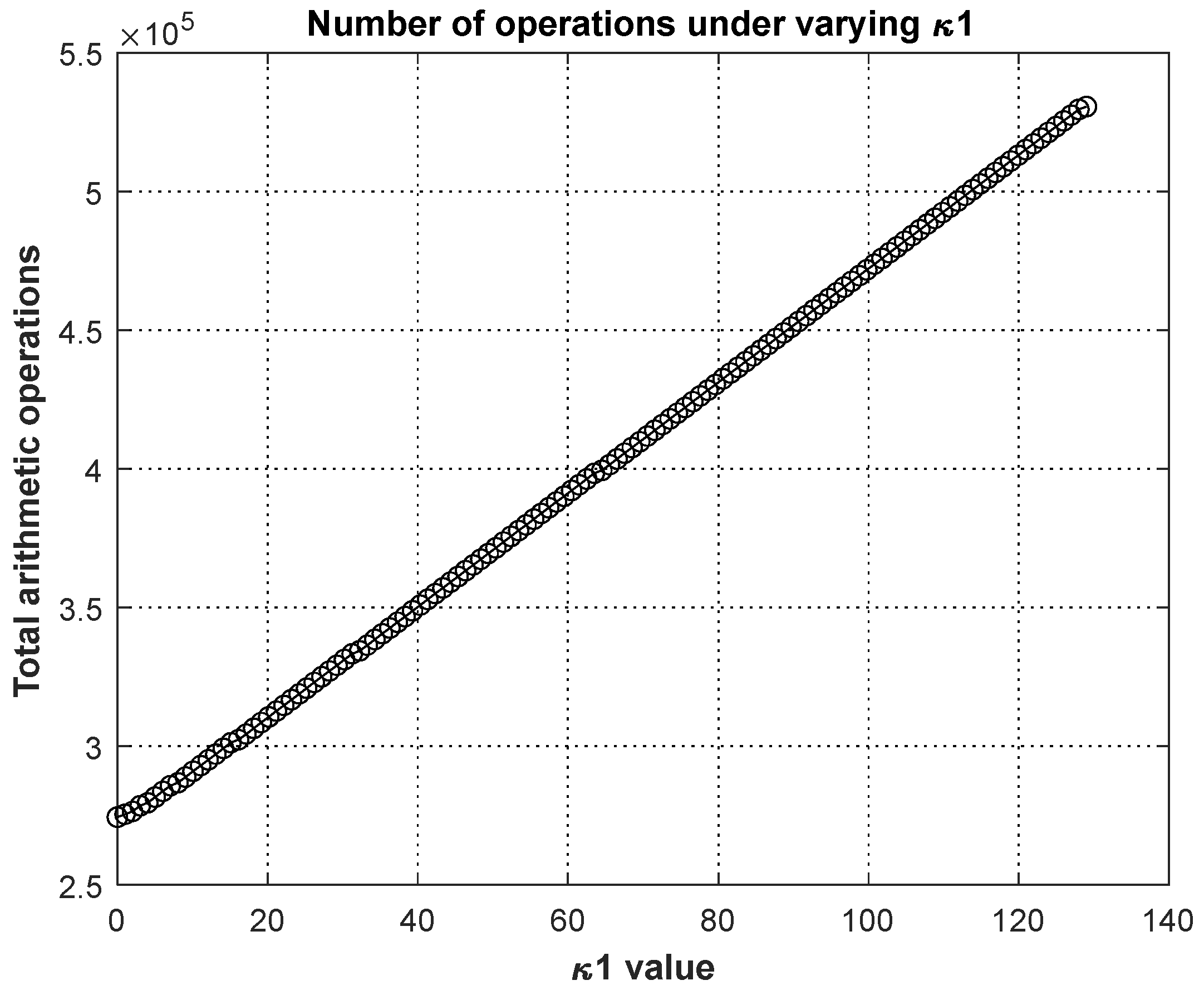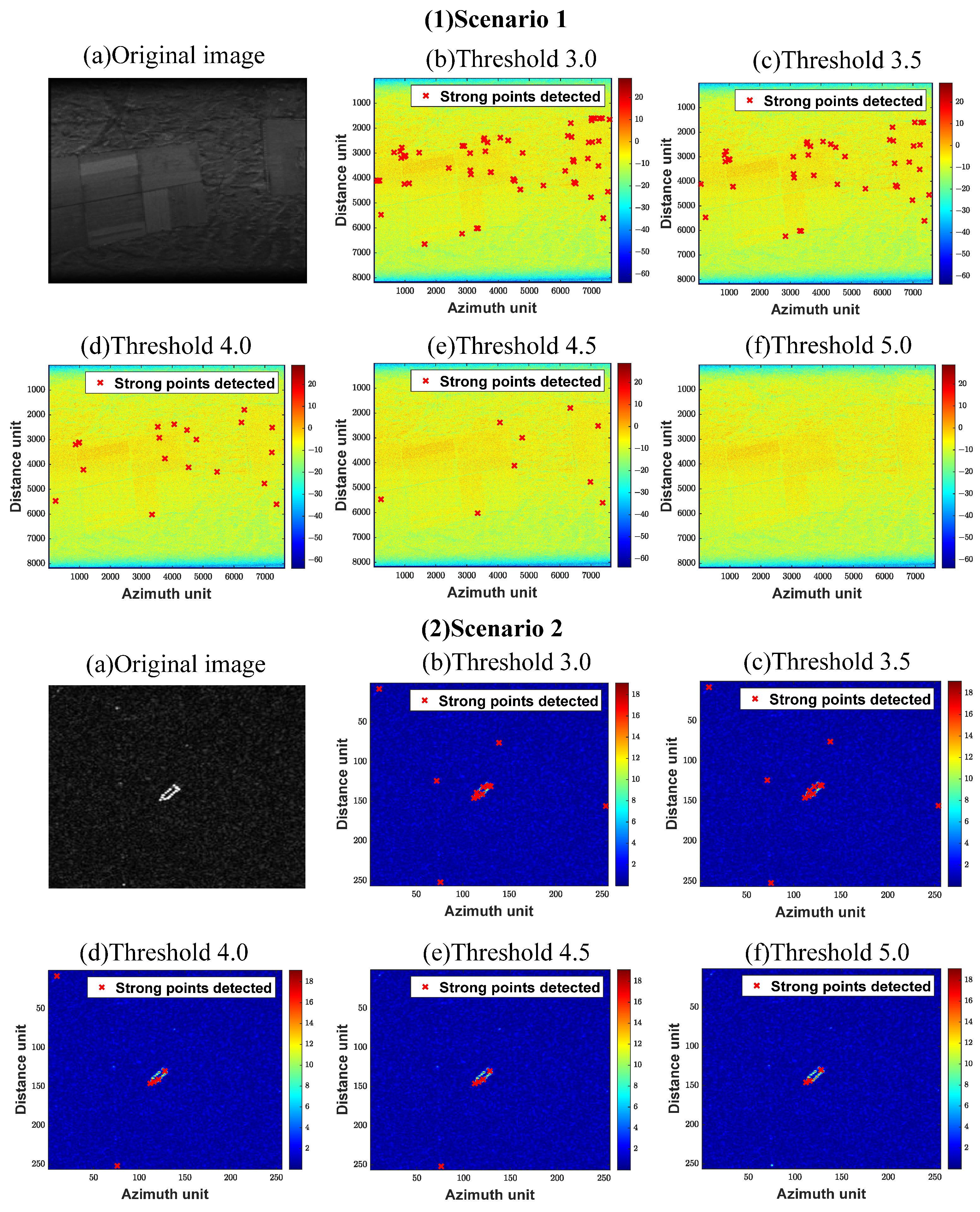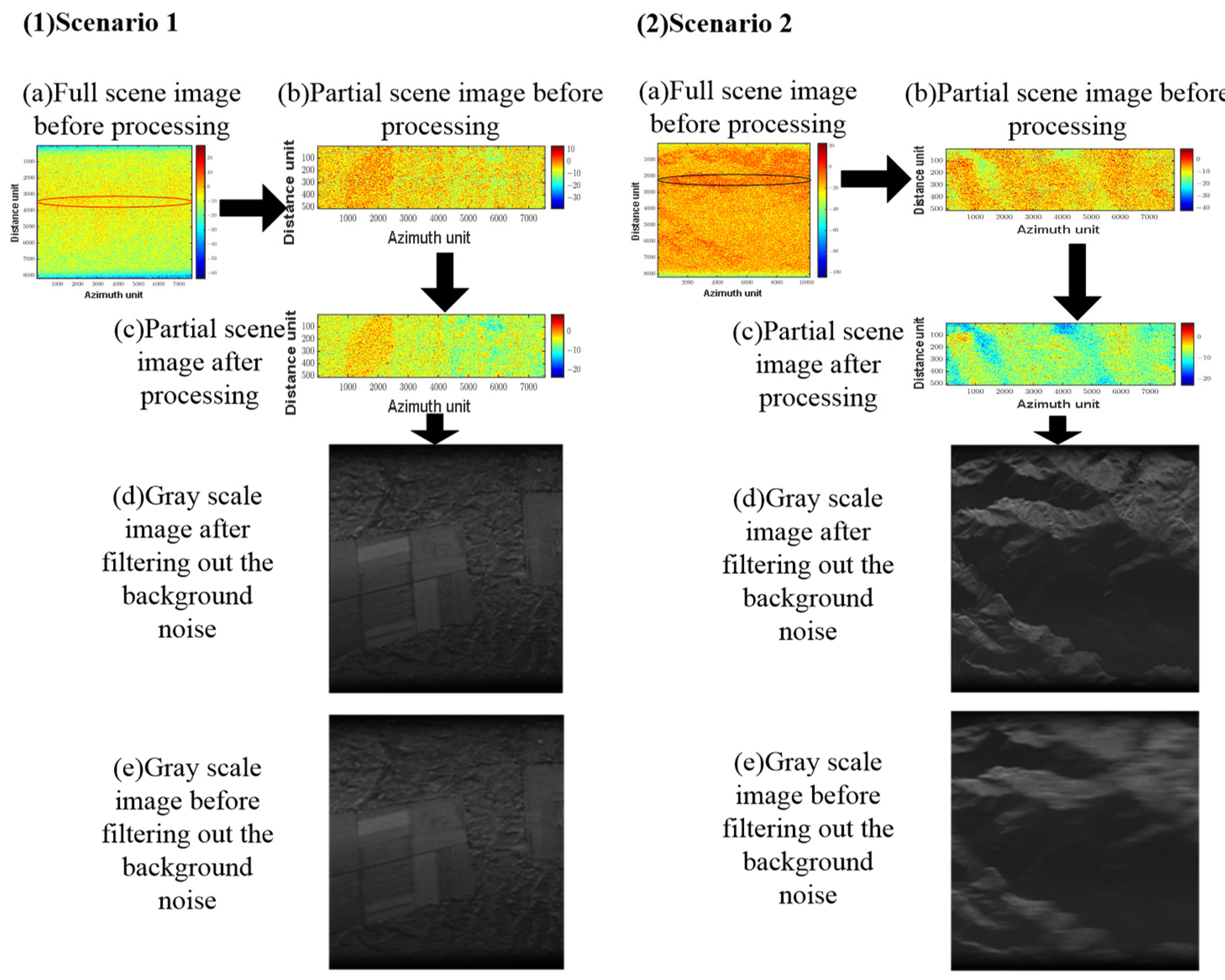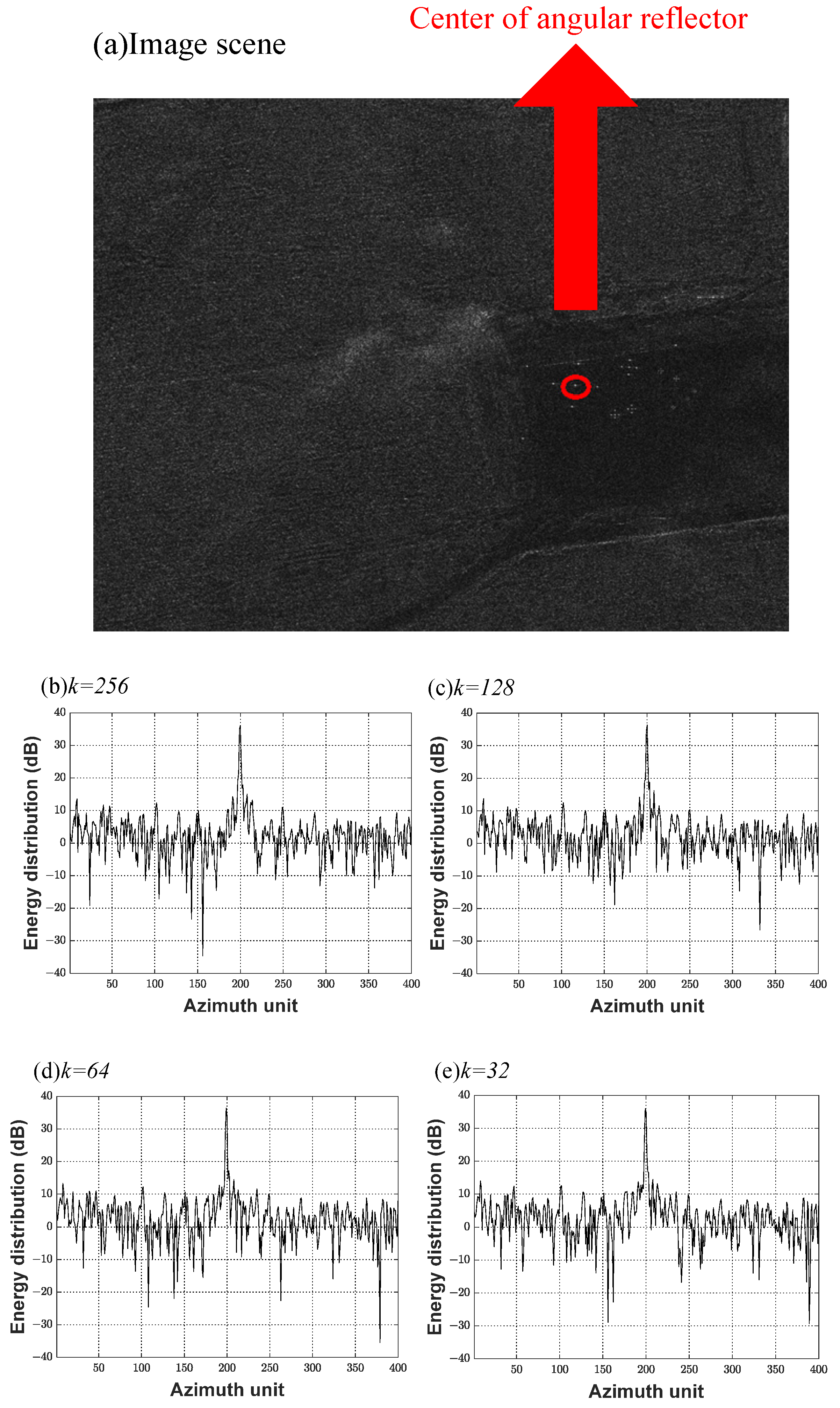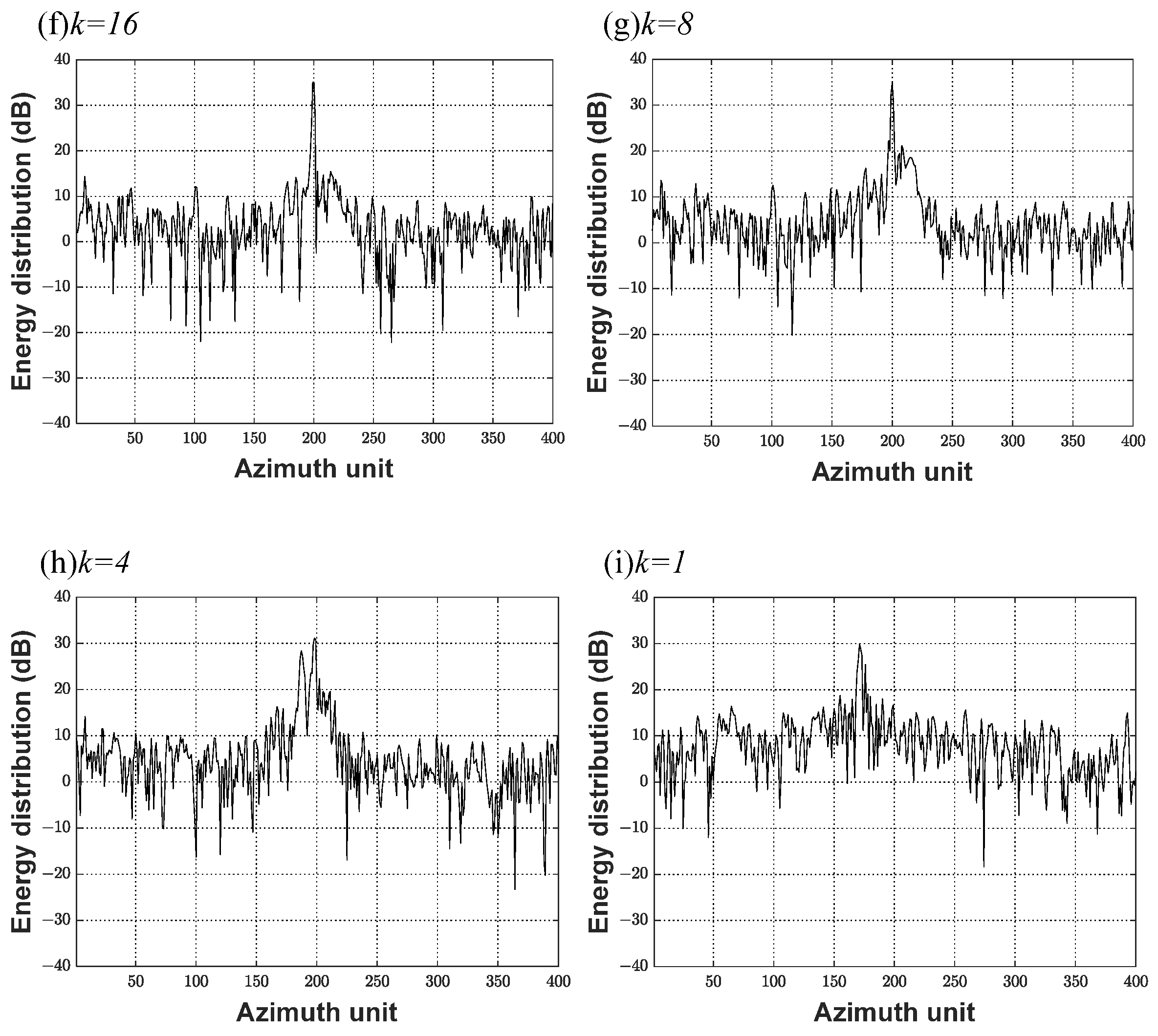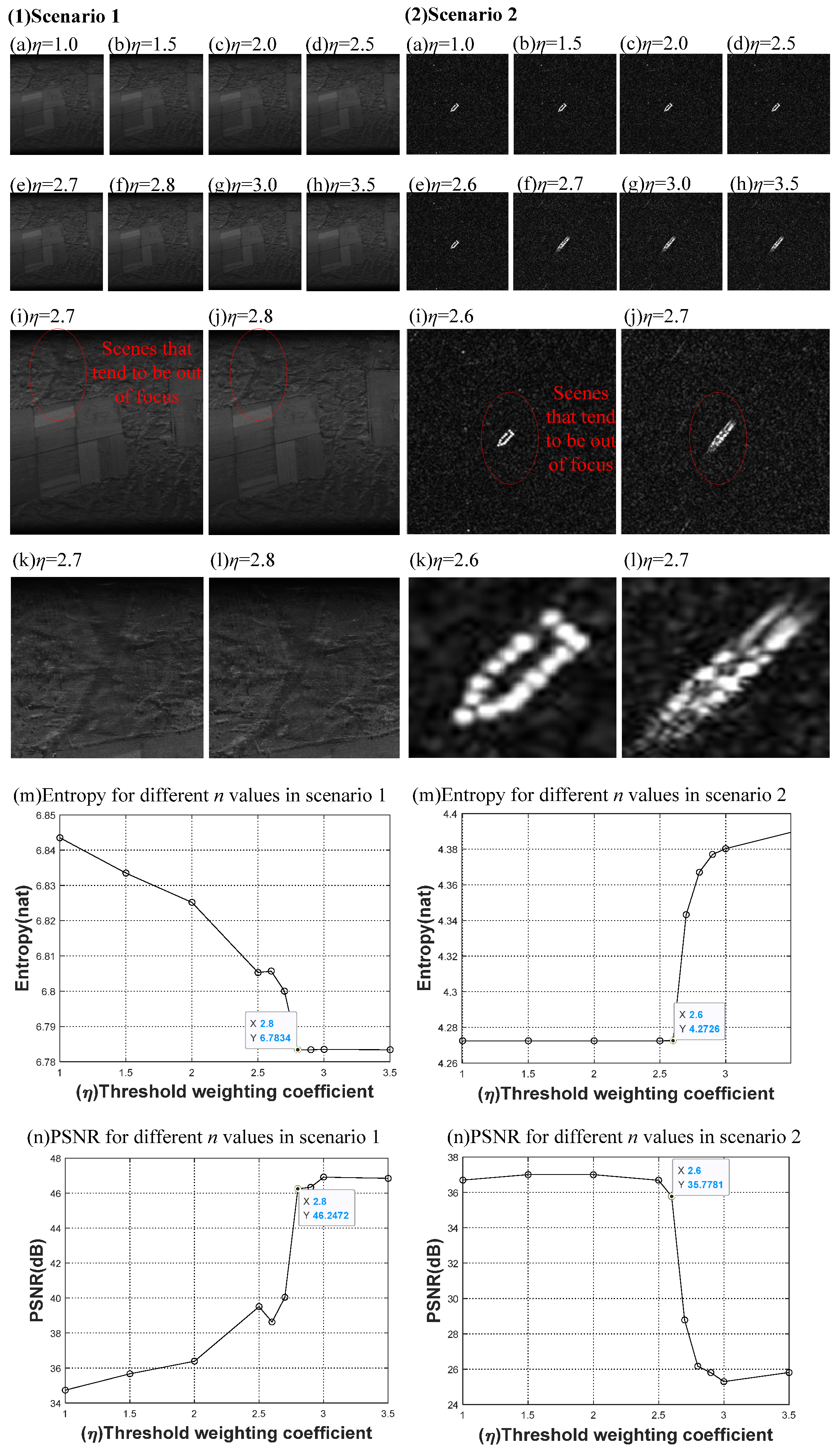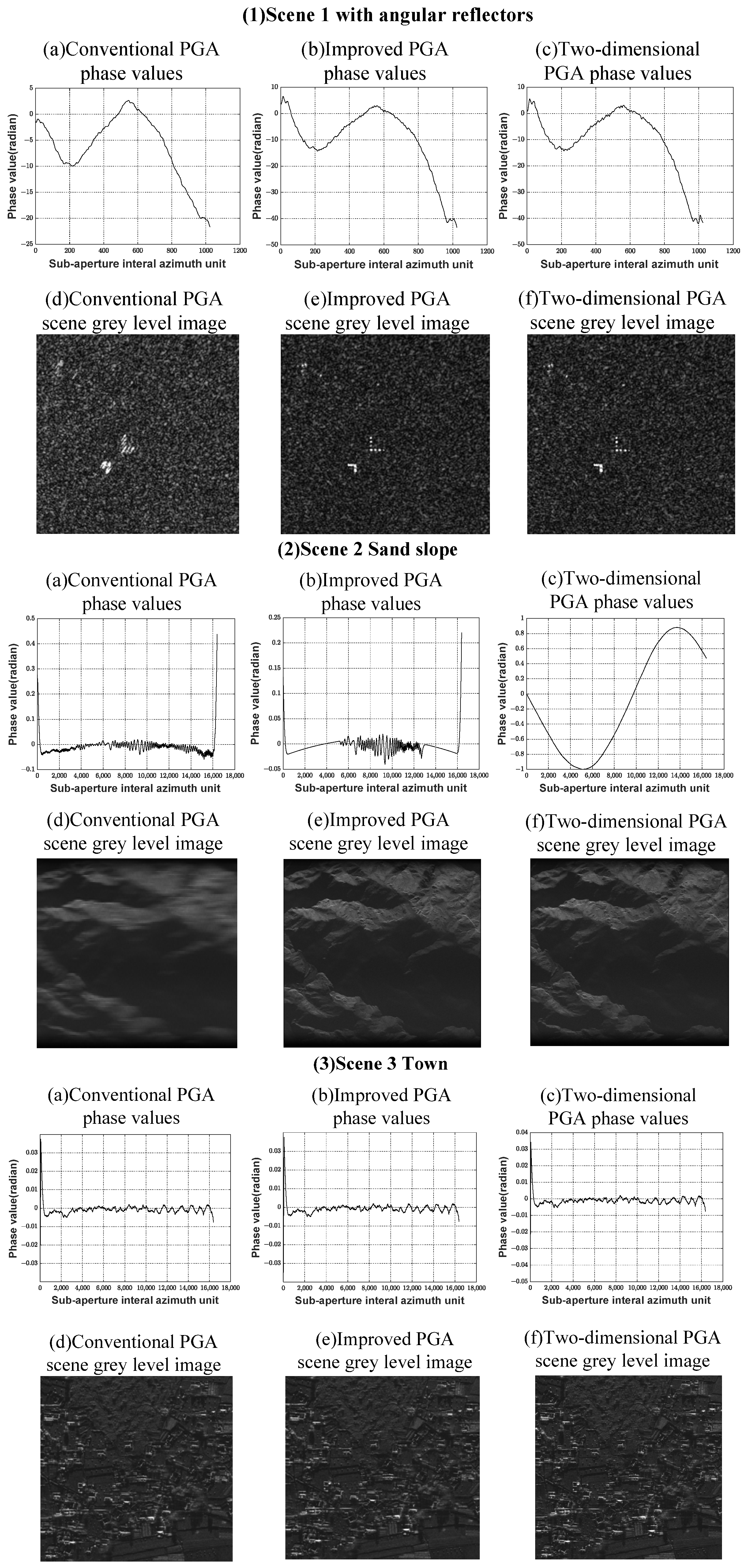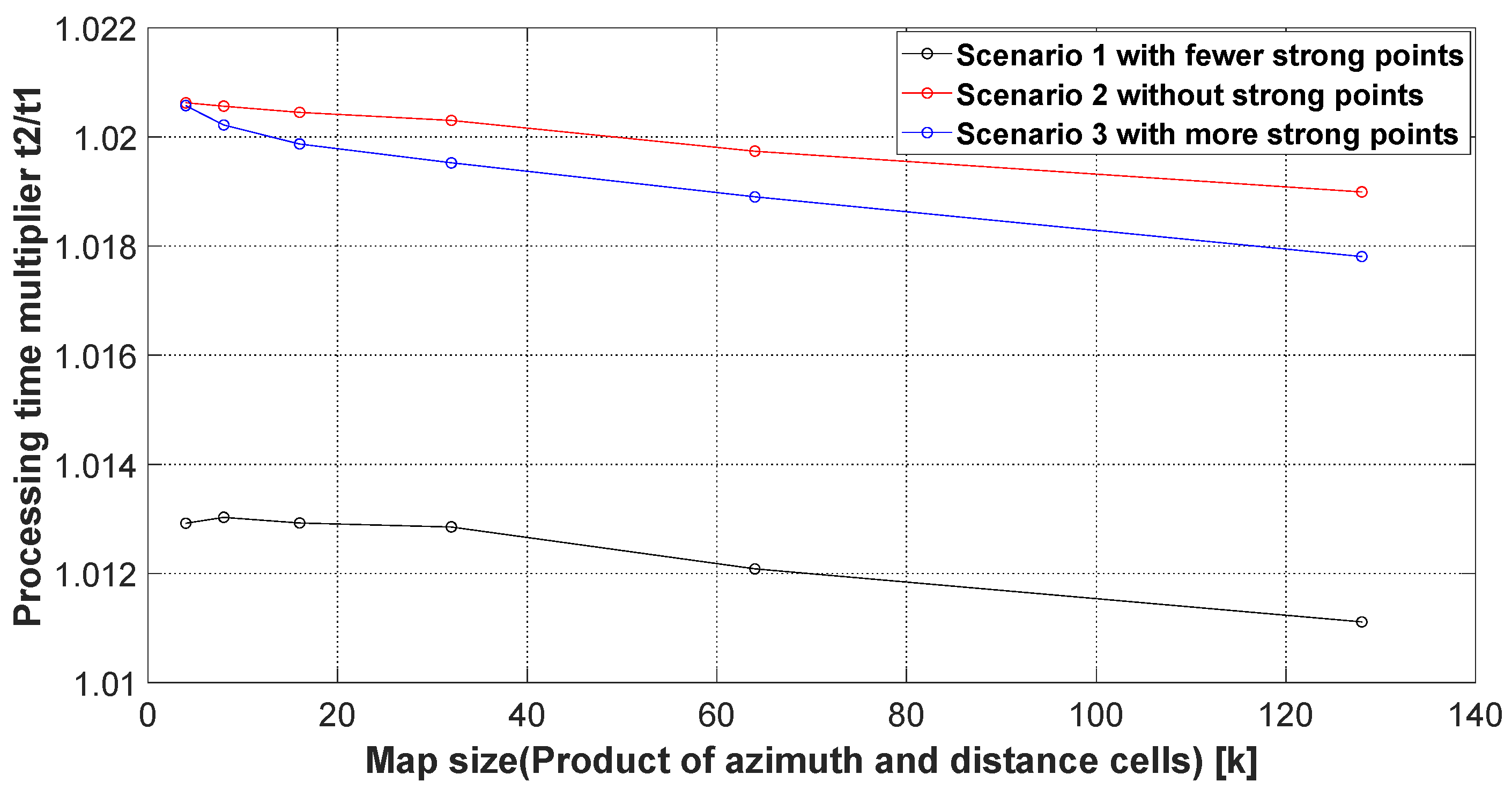1. Introduction
Radar imaging technology originated in the 1950s and is a landmark invention in the field of radar technology [
1]. Compared with optical imaging systems, imaging radar has no light condition requirements and can work 24 h a day; as such, it is of particular use in the field of military intelligence.
At present, synthetic aperture radar (SAR) [
2] is the most widely used radar imaging technology, which is a high-resolution imaging radar utilizing small antennas that move along a long array trajectory while emitting phase-referenced signals and coherently processing the echo signals from different locations. The imaging regime of SAR is expected to be extended and expanded in the future, in terms of its observation dimensions, in order to obtain multi-dimensional information about targets [
3,
4,
5]. In SAR imaging, when the radar system acquires two-dimensional SAR images under different flight paths through repeated observations [
6,
7,
8,
9], the phase error caused by the transmission of echo signals can lead to image defocusing, affecting the quality of the resulting SAR images. With the improvement of imaging resolution, the effect of echo phase error on image defocusing is becoming more and more serious. Although navigation motion compensation systems can compensate for this phase error, to a certain extent, the residual phase error will still lead to scattering in high-resolution images. Therefore, in high-resolution SAR imaging systems, in addition to motion compensation using inertial guidance data, it is usually necessary to automatically estimate and compensate for the residual phase error of SAR echo data. This process is called autofocusing.
Autofocusing techniques based on echo data error correction have been a research hotspots for phase error correction. In this line, one class of methods utilizes autofocusing techniques based on sharpness optimization. Such methods measure the focusing quality through evaluating the sharpness of images and estimate the phase error through iteratively optimizing the sharpness function. Commonly used sharpness evaluation criteria include entropy and contrast, among others. In 2012, Pardini et al. [
10] proposed a method to improve the imaging quality through minimizing the entropy of the inverse profile; however, this method suffers from the problem of bias. In 2018, Aghababaee et al. [
11] introduced phase-gradient constraints in order to overcome this problem. However, this method requires multi-dimensional optimization for each pixel, leading to high computational burdens. In 2020, Feng Dong of the National University of Defense Technology proposed a sharpness-optimized autofocusing method based on intensity-squared maximization [
12], which yielded similar results to the study mentioned above [
11] in terms of imaging quality, while presenting advantages in terms of computational efficiency.
Another class of autofocus algorithms is based on the phase error function, the main representative of which is the phase gradient autofocus (PGA) method [
13]. This method is characterized by the direct estimation of the phase error in the echo signal without the need to model the phase error. Compared with traditional autofocusing algorithms, such as map drift (MD) and phase difference (PD) [
14,
15,
16], the PGA imposes no limitations on the phase error order and can basically adapt to strip and cluster SAR imaging contexts for various scenes. Therefore, the PGA algorithm has been widely used in the field of SAR imaging since its proposal in the 1990s, and as one of the most commonly used autofocusing algorithms, it has attracted great attention in the international SAR imaging field. This algorithm, which abandons the finite-order phase model, is a purely data-driven method providing faster convergence speed and good robustness, and it can provide good compensation for any order phase error, which makes up for the shortcomings of early autofocusing techniques in compensating for the high-order phase error. The traditional PGA algorithm was first proposed for the clustered-beam SAR imaging mode, which is suitable for radar imaging of small scenes [
17]. However, when the PGA algorithm is applied for SAR imaging of large scenes, two problems arise: first, there may be multiple strong scattering centers in the same distance cell in some scenes, which is not conducive to fully extracting the scene phase error; second, in the strip imaging mode, the antenna beam slides along a fixed trajectory at a plateau velocity, and the spatial positions of various scatterers corresponding to the synthetic aperture vary according to their positions with respect to the trajectory. In other words, the SAR imaging system yields different phase errors for scatterers at different spatial locations, and the variation in these phase errors leads to the defocusing of large scenes.
In 1998, Chan proposed the QPGA method [
18], which does not require iteration and only filters the strong scattering points selected in the PGA. Compared with traditional PGA processing, this method demonstrated a substantial reduction in computation and improves the focusing effect, constituting a good improvement for the development of PGA. In 1999, Thompson and Bates presented a PGA extension method based on phase-weighted estimation, which takes into account the variation in the phase error at low observation angles, at the National Radar Conference organized by the IEEE Electrical and Electronics Engineering Society. Using a weighting method to compensate for different spatial positions to different degrees can effectively improve the focusing performance in SAR imaging; however, the huge amount of computation affects the practical value of the method [
19]. In the same year, Wei Ye of Xidian University (XDU), Xi’an, China) proposed a method for phase error estimation using weighted least-squares (WLSs) [
20], which does not require each distance cell in the image to have its own distribution model and presents strong robustness. Zhu Zhaoda and Wu Xinwei from Nanjing University of Aeronautics and Astronautics (NUAA, Nanjing, China) extended the PGA algorithm in 2002; in particular, they utilized the intrinsic connection between the strip and cluster modes and processed the strip-mode imaging data in chunks, where each piece of the data has a certain overlap, and the phase error can be roughly regarded as a non-null-variable, such that the strip-mode data are considered equivalent to the cluster-mode data [
21]. Then, image processing is carried out using the irradiation method of cluster-beam SAR, and the autofocusing process for each piece of data is completed using PGA. Finally, each of the data sub-images is spliced together, thus realizing the chunked PGA processing method of strip SAR. In 2011, Sun Xilong of the National University of Defense Technology (NUDT, Changsha, China) combined the idea of the least squares method [
22] and proposed an improved PGA phase error compensation method to estimate the clutter variance based on the characteristics of the clutter energy in the extrapolated unit. This method has better applicability, due to the infinite qualitative assumption for clutter. A two-dimensional autofocusing algorithm for SAR based on a priori knowledge was proposed by Xinhua Mao and Ocean Cao of NUAA in 2013 in Electronics Letters [
23]. They considered the scattering of SAR images at different distance units and analyzed the structure of the residual error handled by the SAR imaging algorithm, allowing for determination of the internal coupling problem between the distance and orientation errors. This helped them to develop a two-dimensional PGA algorithm with a better focusing effect than the existing one-dimensional PGA. In 2016, Zhang Lei et al. at XUET proposed an improved sub-aperture projection (SATA) algorithm [
24,
25], which corrects the azimuth phase error by calculating the phase error within each sub-aperture. In 2019, Feng et al. [
26] applied the PGA method to the Holo SAR system in order to correct the phase error between different channels. It should be noted that the assumption for the PGA method that the spatial variation in phase error can be ignored may not hold in large scenarios, thus limiting its effectiveness in large-scale applications. In order to solve the phase error correction problem in large scenes, in 2021, Lu et al. [
27] proposed a PGA method based on persistent scatterer (PS) point network construction (NC), which draws on the idea of a PS point network in PS-interferometric SAR (InSAR). The NC-PGA method processes the imaging scene in chunks and uses the PGA method to estimate the phase errors in subchunks. In each sub-block, the PS-point network is used to estimate the PS-point heights, thus avoiding the height offset problem between sub-blocks. In 2022, Lu et al. [
28] optimized the network structure of NC-PGA. Their method uses a partially overlapping PS-point network, which significantly reduces the computational burden.
In the existing PGA algorithms, phase gradient estimation is required to estimate the phase difference based on the strong scattering points of the scene in the two-dimensional data domain. However, in some special scenes—such as the Gobi Desert and certain other scenes—with insufficient or a lack of strong scattering points, when the strong scattering points are selected for phase error estimation, the low signal-to-noise ratio of the samples of the strong scattering points leads to inaccurate estimation of the phase error, which, thus, leads to azimuth-scattered focus. In order to solve this problem, this study proposes an adaptive strong scattering-point selection method based on the mean value of the scene. The novelty of this method is that it improves the robustness of the PGA, and the radar can focus well within different scenes.
3. Results
The radar used for the collection of the utilized real-world data was an airborne reconnaissance high-resolution radar, the main function of which is radar imaging processing. The radar is a phase reference radar of a certain band. The antenna is installed in the nose direction with a 90° front and side view, with a downward view angle of about 1.5°. For the several scenarios considered in this study, the carrier aircraft flew horizontally at a speed of about 60 m/s. The height of the aircraft’s flight field was about 3000 m.
3.1. Azimuth CFAR Processing
As the improved PGA processing method proposed in this study, as well as Equations (12) and (13), can only be applied in scenes with strong scattering points, judging whether there are strong scattering points in the scene is the first step of the improved PGA algorithm. The experimental results of one-dimensional azimuth CFAR processing on the data of several different scenes before entering the PGA processing are detailed in the following:
As can be seen from
Figure 8, the images were subjected to azimuth CFAR detection prior to PGA processing, and the detected points are shown in
Figure 8(1b–1f,2b–2f) and
Table 2, where the number of points detected in the image after azimuth CFAR was correlated to
(i.e., the dynamic threshold coefficient of CFAR), and fewer points were detected as
increased. When
, the false alarm rate was only 1.3%, and only strong scattering points that are 13.9794 times higher than the detection threshold value could be detected, indicating that the dynamic threshold is already large. At this time, the points were no longer detected in Scenario 1, while three points were detected in Scenario 2. This indicates that there were strong scattering points in Scenario 2, such that subsequent PGA processing was carried out for Scenario 2, while this processing was skipped for Scenario 1.
3.2. Bottom Noise Removal
This section performs mean filtering of the noise floor for scenes that do not cross the one-dimensional CFAR threshold. The experimental process to determine the image entropy value was as follows:
where
is the magnitude of each pixel point in the image,
is the number of azimuth points in the whole image, and
is the number of distance points in the image.
denotes the entropy value of the image, where larger values indicate a more chaotic system.
The PSNR is calculated as follows:
where
represents the number of image distance units,
represents the number of image distance units,
represents the magnitude of each pixel point of the processed image,
represents the magnitude of each pixel point of the reference image,
represents the mean square error between the processed image and the reference image, and
represents the magnitude of the largest point in the amplitude of the processed image. In this study, the reference maps for PSNR are selected from SAR maps of the same scene with special image processing. Its focusing effect is generally recognized.
Table 3 and
Figure 9 show the experimental results of the original scene images after PGA processing and after denoising:
From
Table 3, it can be seen that when there are almost no strong scattering points in the scene, giving the image a mean filter denoising before doing the PGA processing will make the entropy value of the image larger. From
Figure 9, it can be seen that the noise floor in the image is significantly suppressed by the denoising process of this method through scene 1
Figure 9(1b,1c) and scene 2
Figure 9(2b,2c). The comparison of
Figure 9(1d,1e) and
Figure 9(2d,2e) also clearly shows that the quality of the image filtered by the noise floor is better focused.
Therefore, when there is no strong scattering point in the scene and the threshold is not exceeded in CFAR detection, the scene is first rejected by the mean noise floor, and then, PGA processing can make the image focusing effect better than the direct PGA processing focusing effect.
3.3. Determination of k Value
In the PGA calculation process, the distance of the strong scattering points in the scene is selected to estimate the phase error. When selecting the distance of the strong scattering points, the accuracy is not the highest when selecting the strong scattering point with the largest distance. This is because SAR imagery also includes interference due to background clutter, and the good focusing performance of the PGA algorithm is based on the use of a suitable statistical model. If the sample distance for the strong scattering points participating in the estimation process is too small, it can result in inaccurate phase error estimation [
38]. This experiment involved PGA processing of a scene utilizing different numbers of strong scattering points. Statistically, the azimuth signal-to-noise ratio of a certain strong scattering point is determined, as shown in
Figure 8a.
From
Figure 10f–i, it can be seen that, when too few strong scattering points are selected to carry out PGA, the proposed algorithm loses the statistical regularity of the clutter background, and the supporting region around the sample points in the image becomes unstable. From
Table 4, it can be seen that, when fewer than 32 points were selected, the image azimuth primary and secondary valve ratios decreased dramatically, thus affecting image focusing. When no fewer than 32 strong scattering points
k were selected, it can be seen from
Figure 10b–e and
Table 4 that the region surrounding the sample points in the image was more stable, and the primary and secondary valve ratio was maintained at ≥21 dB. Based on the above statistics and consideration of the number of arithmetic operations, it was decided that the initial value of
for processing all the scenes should be set to 128 points.
3.4. Determination of η Value
For the next experiment, we set and then assessed the focusing effect under different values in multiple scenes and in the same scene.
The focusing effect for two scenes under various
values is shown in
Figure 11.
The focusing effect under different values of
can be seen in
Figure 11(1a–1h). When
is small, the focusing effect is poor. The focusing effect was improved when
, as shown in
Figure 11(1e), but scattering can be observed in
Figure 11(1i), with its zoom shown in
Figure 11(1k). When
, it can be seen from
Figure 11(1j)—as well as its zoom shown in
Figure 11(1l)—that the position where there is scattering in
Figure 11(1k) is better focused. The whole picture can be seen in
Figure 11(1j),indicating a good focusing effect. It can also be seen from
Table 5 and
Figure 11(1m) that the image entropy value was large and fluctuated when
. Using the information in
Figure 11(1n) and
Table 5, it is also known that when
, the value of PSNR is relatively small, indicating more image distortion compared to the standard image. Meanwhile, when
, the image entropy value and PSNR tend to stabilize. As there are almost no strong points in the scene, the phase error of the strong point estimated by the PGA algorithm was not obtained. It can be seen that, when there is no strong point in the scene (meaning that the image is not defocused), the optimal value of
is in the range of
. The PGA estimation process is performed when
, indicating that the selected strong points are larger than the mean value of the non-strong points, resulting in image defocusing.
The focusing effect under different values of
can be seen in
Figure 11(2a–2e). When
was small, the focusing effect was good; however, in
Figure 11(2f–2h), angular reflector scattering can be clearly seen. It can also be seen from
Table 5,
Figure 11(2m,2n),that, when
, the entropy value of the image is smaller and tends to stabilize, the PSNR value of the image is larger and also tends to stabilize, and the image is better focused, as can be seen from
Figure 11(2i) and its zoom shown in
Figure 11(2k). When
, the image entropy value was large and fluctuated, the PSNR value of the image was smaller, and the image was defocused, as shown in
Figure 11(2j) and its zoomed version in
Figure 11(2l). The difference between scenes 1 and 2 is that scene 1 had almost no strong points, such that the image focusing effect will be better without PGA. In contrast, scene 2 presents corner reflectors; therefore, in order to focus on the corner reflectors well, scene 2 should be subjected to PGA processing. It can be seen that, when there are strong scattering points in the scene, in order to prevent the strong scattering points in the image from being scattered, PGA processing must be carried out. At this time, the
value is in the range of
. The PGA estimation process is not performed when
, indicating that the selected strong points are smaller than the mean value of the non-strong points, which results in scattering of the strong points in the image.
In summary, when there is no strong scattering point in the image, in the case of
, if PGA processing is carried out, the image will be out of focus. When there is a strong scattering point in the image, in the case of
, if PGA processing is carried out, the image will be in focus. It can be inferred that, when the value of
is taken near 2.6, regardless of whether there is a strong point in the scene, PGA processing will be carried out—although
meets the condition,
is too small according to Equations (12) and (13) for strong point amplitude, and regardless of whether the constraints are large enough or not, they will be lowered and the maximum value of
will be taken. However, as
takes a value of 2.6 when no strong point in the scene is scattered, the selection of strong scattering points must be carried out initially, in order to determine whether any strong points are present (as introduced in
Section 3.1).
3.5. Iterative Algorithm Validation
Although it was determined in
Section 3.4 that the value of
is in the range of 2.6 to 2.8, the above processing was based on the use of
for the calculation. For some points in the scene with strong scattering points, the ratio of
to
calculated under
is not in the range of
. At this time, the iterative operation of
is needed. According to Equation (13), when
is smaller,
will increase and
will decrease, which will make the ratio
larger. Through iterating to a certain
value that satisfies
, the subsequent PGA phase error estimation is performed with the number of strong scattering points
at this point. When
is reached, if the condition is still not satisfied, the subsequent PGA phase error estimation is not processed. For example,
Figure 12a–h show the image focusing effect after selecting different numbers of strong scattering points for PGA phase error estimation in a certain scene.
Figure 12i,j and
Table 6 show the statistics of
,
, and
, as well as the entropy and PSNR values for different values of
in this scene.
As can be seen from
Table 6 and
Figure 12i, with the calculation of the proposed improved PGA algorithm using
, it initially does not satisfy the range of
. At this time, the dispersion in the image is shown in
Figure 12a, and the entropy value is large in
Figure 12j and the PSNR value is small in
Figure 12k. Accordingly, Equation (13) is used for iteration, and
will be used for the second calculation. It was found that the value of
also does not satisfy the range of
, and the resulting image is also out of focus. In the next step, using
for the calculation, according to
Figure 12i and
Table 6,
is brought into the range of
, leading to as mall entropy value and well-focused image. The above results indicate that the PGA processing of this scene at
and
is not effective, as when using the proposed improved algorithm, from
Figure 12i and
Table 6,
was not in the range of
. The iterative computation was thus continued and iterated to
for processing. According to
Figure 12i and
Table 6, the condition
was satisfied at
, and performing subsequent PGA phase error estimation can achieve good results. Moreover, as shown in
Table 6,
and
were also in the range of
and were subjected to subsequent PGA calculations. As can be seen from
Figure 12d–k and
Table 6, the image entropy and PSNR values were more stable, and the images were well-focused. At the same time,
yielded values outside the range of
, and according to
Figure 12f–h,j,k and
Table 6, it can be seen that the entropy values are large and unstable and the PSNR value is small, while the image focusing effect is not only bad, but furthermore, in
Figure 12g,h, the images also present heavy shadows.
In summary, the iterative algorithm proposed in this study significantly improves the focusing effect for scenes with strong scattering points and is able to adaptively select the number of strong scattering points for PGA phase error estimation according to the scene.
3.6. Comparative Validation of Algorithms on Real Data
After the above experiments, in order to verify the effectiveness of the improved PGA algorithm proposed in this study, three groups of scenes (the first group with few strong points, the second with almost no strong points, and the third with strong points almost covering the whole scene) were selected for further experiments. In this experiment, we added a two-dimensional advanced algorithm from a well-known university in China and used the data of this algorithm in the experiment as a reference. The obtained experimental results are as follows:
The SAR data from the desert scene with angular reflectors, processed using conventional PGA, two-dimensional PGA, and the proposed improved PGA process, are shown in
Figure 13(1a–1f) and
Table 7. From
Figure 13(1d), it can be seen that applying conventional PGA caused the scene to appear scattered. From the smoother sub-aperture phase error information in
Figure 13(1a), it can be concluded that, in the case where there are few strong points in the scene, inaccurate phase estimation will lead to an out-of-focus scene when the phase error is estimated using conventional PGA. The phase error information estimated using the improved method proposed in this study is shown in
Figure 13(1b), which follows the same trend as the phase error estimated by the conventional method in
Figure 13(1a); however, it is not as smooth when the phase error was estimated using the conventional method, as if each azimuth unit had been stitched together with some gradient variation. The effect of using two-dimensional PGA to process the data of this scene is similar to the improved method in this study in terms of phase estimation in
Figure 13(1c) and gray map
Figure 13(1f), but the improved PGA is slightly better than the two-dimensional PGA in terms of the entropy and PSNR values in
Table 7. Therefore, the processing results shown in
Figure 13(1e) are better focused.
Next, the SAR data of sandy slopes were processed using conventional PGA, two-dimensional PGA, and the proposed improved PGA process, as shown in
Figure 13(2a–2f). From
Figure 13(2d), it can be seen that applying conventional PGA caused the scene to appear scattered. From the large fluctuation in the sub-aperture phase error information in
Figure 13(2a), it can be concluded that, in the absence of a strong point in the scene, the phase error estimation using a conventional PGA also resulted in a scattered focus situation due to inaccurate phase estimation. From
Figure 13(2f), it can be seen that the image is well focused by utilizing the two-dimensional PGA processing. Similarly, the phase error information estimated after using the improved method in this paper is shown in
Figure 13(2b); due to the absence of strong scattering points in the scene, the improved PGA is processed with the removal of bottom noise. Incorrect phase errors are eliminated from the PGA phase error estimation, and the scene focusing effect was significantly improved, as can be seen from
Figure 13(2e). However, from
Table 7, it can be seen that the two-dimensional PGA is better than the improved PGA in this paper in terms of the entropy and PSNR values. So the focusing effect of this scene is two-dimensional PGA > improved PGA > conventional PGA.
Finally, the SAR data for a town scene were processed using conventional PGA, two-dimensional PGA, and the proposed improved PGA process, as shown in
Figure 13(3a–3f) and
Table 7. It can be seen that applying the three PGA treatments is comparable in scenes with more strong points, such as the town scene considered here.
3.7. Real-Time Validation
The real-time processing time statistics for the three scenarios detailed in
Section 3.6 are provided in
Table 8.
According to
Table 8, it can be seen that under the same image size, the processing time of two dimensions is almost two times that of the time of conventional PGA and the improved PGA in this paper, and the processing time of two dimensions is not discussed here. The improved PGA in this study performs mean noise floor filtering after one-dimensional CFAR processing judgment when the scene has no strong points and then performs PGA processing. The processing time increases with the image size from 2.08% for 2 k × 2 k to 1.90% for 8 k × 16 k. When there are strong points in the scene, the maximum time increase using the improved PGA processing in this study does not exceed 2.04%. With the absolute time of 2.4371 s for conventional PGA processing, the increase in time incurred by the improved PGA process will be no greater than 0.05 s. For a 2 k × 2 k image, the shortest time to produce a graph is within the order of 0.5 s, and the increase in the improved PGA over the conventional PGA in this study is in the order of 0.001 s, which affects the time almost negligibly. For 8 k × 16 k images, the shortest time to produce a picture is of the order of 10 s, and the increase in this paper’s improved PGA over the conventional PGA is in the order of 0.01 s, which also affects the time almost negligibly. As can be seen from
Figure 14, when the size of the processed image is larger, the improved PGA time in this study and the conventional PGA processing time become closer and closer. This is due to the fact that as the amount of data increases, the multi-core parallel mechanism exerts more and more advantages.
